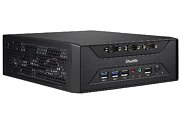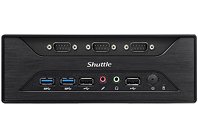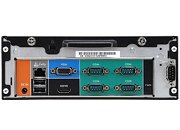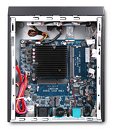Thursday, June 22nd 2017

Shuttle Announces its First Fanless PC in a 3-litre Format
Especially intended for out of the ordinary use in vertical markets, Shuttle is now offering a fanless barebone PC in a versatile 3-litre format. Under the name XC60J, the range of the mini PC manufacturer now adds a 7 cm tall mini PC with an Intel Celeron J3355 dual-core processor (2 GHz) in 14 nm architecture.
The virtually silent platform, which is suitable for constant operation (24/7) at an ambient temperature of up to 40 °C, boasts a total of eight serial interfaces (8x RS-232, one of which can be switched to RS-422/RS-485) as its key spec and is therefore aimed at the areas of automation, POS, industry and machine control in which USB or IP-based transmission will not apply."Serial interfaces are used more frequently than you would expect in vending machines, checkout systems, machinery and in many areas of automation and control," says Tom Seiffert, Head of Marketing & PR at Shuttle Computer Handels GmbH. "This product, which, at first sight, might sport some rather unusual features by today's standards, combines the very latest energy-saving technology with already proven technology that has been around for decades and is still in use today."
Its robust steel chassis houses the mainboard with an Intel Celeron processor (Apollo Lake) and Intel HD Graphics 500. Up to 8 GB of DDR3L memory and a 3.5" hard disk or 2.5" SSD can be installed as desired. The two free M.2 slots (1x M.2-2280 and 1x M.2-2230) can be used, for example, for an NVMe SSD and a WLAN module. Front and back panel reveal 1x HDMI, 1x VGA, 2x USB 3.0, 4x USB 2.0, Gigabit Ethernet, audio connections and the mentioned eight serial interfaces.
Instant system start-up, once power is applied, can be forced by setting a jumper. This is ideal, for example, if the machine is installed in a remote and difficult to access place or if there is a power outage. The actual power supply is 19 V. Alternatively, the XC60J can also be operated at 12 V.
Optionally available accessories include a stand (PS01), VESA mount/wall mount (PV02) and WLAN kit (WLN-M).
The recommended retail price from Shuttle for the XC60J is EUR 192.00 (excluding VAT). For more information, visit the product page.
The virtually silent platform, which is suitable for constant operation (24/7) at an ambient temperature of up to 40 °C, boasts a total of eight serial interfaces (8x RS-232, one of which can be switched to RS-422/RS-485) as its key spec and is therefore aimed at the areas of automation, POS, industry and machine control in which USB or IP-based transmission will not apply."Serial interfaces are used more frequently than you would expect in vending machines, checkout systems, machinery and in many areas of automation and control," says Tom Seiffert, Head of Marketing & PR at Shuttle Computer Handels GmbH. "This product, which, at first sight, might sport some rather unusual features by today's standards, combines the very latest energy-saving technology with already proven technology that has been around for decades and is still in use today."
Its robust steel chassis houses the mainboard with an Intel Celeron processor (Apollo Lake) and Intel HD Graphics 500. Up to 8 GB of DDR3L memory and a 3.5" hard disk or 2.5" SSD can be installed as desired. The two free M.2 slots (1x M.2-2280 and 1x M.2-2230) can be used, for example, for an NVMe SSD and a WLAN module. Front and back panel reveal 1x HDMI, 1x VGA, 2x USB 3.0, 4x USB 2.0, Gigabit Ethernet, audio connections and the mentioned eight serial interfaces.
Instant system start-up, once power is applied, can be forced by setting a jumper. This is ideal, for example, if the machine is installed in a remote and difficult to access place or if there is a power outage. The actual power supply is 19 V. Alternatively, the XC60J can also be operated at 12 V.
Optionally available accessories include a stand (PS01), VESA mount/wall mount (PV02) and WLAN kit (WLN-M).
The recommended retail price from Shuttle for the XC60J is EUR 192.00 (excluding VAT). For more information, visit the product page.




12 Comments on Shuttle Announces its First Fanless PC in a 3-litre Format
Too bad there are no J3455 versions yet. And no expansion slots, so I can install second NIC.
I guess I'm gonna gave to stick with my semi-working AsRock Q1900B-ITX.
It may be not as practical in the real world, but it's probably a fun setup for some lazy nerd like me. Unlike Shuttle reps, I don't see real practical benefit of having x7 RS232 ports on the motherboard, rather than on an inexpensive external hub (which can be purchased/replaced/repaired/upgraded separately at any time, and ranges from 4 to 24 ports). Most devices used in their examples easily get by with 2-3 serial ports, and conventional PoS peripherals have many USB analogs at the same price tag(if not cheaper). Typical stuff, like bill acceptors. token/coin acceptors, barcode/RFID scanners migrated to USB many years ago.
To clarify:
- Atom: sub 5W (except some Avoton and few other models)
- Celeron/Pentium Jxxxx/Nxxxx are mostly sub 10W SoCs
Not sure why either one of you, guys, got the idea of these chips being dead. The more the merrier!
BTW, Denverton is coming this year. It's a friggin 16-core Atom CPU! You can run a small VPS operation on one of those.